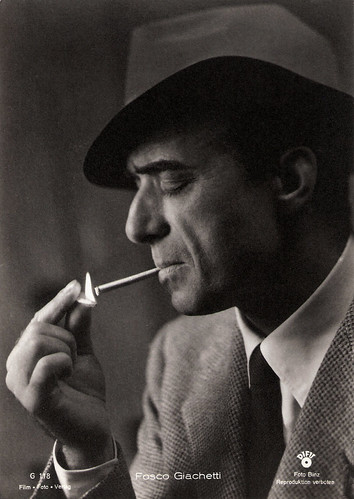
Italian postcard by ASER. Photo: Bassoli, Tirrenia. Fosco Giachetti in Bengasi (Augusto Genina, 1942). At the Venice Film Festival of 1942, Giachetti received the Coppa Mussolini for best actor for his role in this propaganda film on the war in Africa between the British and the Italians.

German postcard by Ross-Verlag, no. A. 3420/1, 1941-1944. Photo: DIFU.

Italian postcard by Agfa. Fosco Giachetti and Conchita Montes in Carmen fra i rossi/In the Red Hell (Edgar Neville, 1939).

Italian postcard by Agfa. Vivi Gioi and Fosco Giachetti in L'amante segreta/The Secret Lover (Carmine Gallone, 1941).

Italian postcard by ASER (A. Scarmiglia Edizioni Roma), no. 226. Photo: Vaselli / Fauno Film. Fosco Giachetti in Fari nella nebbia/Headlights in the Fog (Gianni Franciolini, 1942).

Italian postcard by B.F.F. Edit., no. 4403. Photo: Pesce / Scalera Film. Fosco Giachetti in Noi Vivi/We the Living (Goffredo Alessandrini, 1942).
Dimmed lights
Fosco Giachetti was born in Livorno, Italy in 1900. He was the brother of actor Gianfranco Giachetti. Among his first film appearances were the protagonists of Luci sommerse/Dimmed Lights (Adelqui Migliar, 1934) and of Lo squadrone bianco/The White Squadron (Augusto Genina, 1936).
He became the leading man in such fascist propaganda films as Tredici uomini e un cannone/Thirteen Men and a Cannon (Giovacchino Forzano, 1936), Sentinelle di bronzo/Sentinels of Bronze (Romolo Marcellini, 1937), Scipione l'Africano/Scipio the African (Carmine Gallone, 1937), the Italian version of Carmen fra i rossi/Carmen Among the Reds (Edgar Neville, 1939) and L'assedio dell'Alcazar/The Siege of the Alcazar (Augusto Genina, 1940) with Mireille Balin and Maria Denis.
At the 1942 Venice Film Festival, Fosco Giachetti won the Best Actor award for another propaganda film, Bengasi (Augusto Genina, 1942) with Amedeo Nazzari.
Giachetti co-starred with Alida Valli and Rossano Brazzi in Goffredo Alessandrini's unauthorized 1942 film version of Ayn Rand's novel We the Living. The film appeared in Fascist Italy in two separate parts: Noi Vivi/We the Living and Addio, Kira/Goodbye, Kira, but they are essentially one film.
It was the grim story of post-revolutionary Russia, the forced collectivization of the economy and the brutal suppression of human rights, all told from the viewpoint of one woman, Kira. Ayn Rand's novel was autobiographical and was essentially a diatribe against the loss of individuality in totalitarian societies. The film attracted a sizable audience in Italy. The Fascist government saw the film(s) as a condemnation of Soviet misery. Still, when it became aware that the film(s) implied a condemnation of all totalitarian states, left and right, it withdrew them from distribution.

German postcard by Film-Foto-Verlag, no. G 165, 1941-1944. Photo: Binz, Berlin.

German postcard by Film-Foto-Verlag, no. G 118, 1941-1944. Photo: DIFU / Binz, Berlin.

German postcard by Film-Foto-Verlag, no. G 206, 1941-1944. Photo: DIFU / Binz, Berlin.

German postcard by Film-Foto-Verlag, no. A. 3512/1, 1941-1944. Foto Binz / DIFU.

German postcard by Film-Foto-Verlag, no. A 3788/1, 1941-1944. Photo: DIFU / Binz, Berlin.
The conformist
During the Second World War, Fosco Giachetti also acted in Un colpo di pistola/A Pistol Shot (Renato Castellani, 1942), and Fari nella nebbia/Headlights in the Fog (Gianni Franciolini, 1942), but with less success than he used to have before the war.
After the war, he returned to the stage. He appeared in Spain in the films Nada/Nothing (Edgar Neville, 1947) and Carne de horca/Sierra Morena (Ladislao Vajda, 1953).
In 1959 he had a supporting role in Dino Risi's successful comedy Il mattatore/Love and Larceny, starring Vittorio Gassman.
In 1964, he appeared in a TV adaptation of A. J. Cronin's novel The Citadel, La Cittadella. Other films in which he appeared were La Monaca di Monza/The Nun of Monza (Carmine Gallone, 1962), the musical Samba (Rafael Gil, 1965) with the popular Spanish star Sara Montiel, and the masterpiece Il conformista/The Conformist (Bernardo Bertolucci, 1970).
Fosco Giachetti died in 1974, in Rome, Italy, because of heart problems. In 2003, in Sesto Fiorentino a gallery was opened in tribute to him, the Galleria Fosco Giachetti.

Italian postcard by Zincografica, Firenze. Photo: Scalera Film / Era Film, Roma. Publicity still for Noi Vivi/We the Living (Goffredo Alessandrini, 1942).

Italian postcard with Alida Valli.

Italian postcard, no. 62/2.

Italian postcard by Agfa.

Italian postcard by Aser, Rome, no. 108. Photo: Pesce.

Spanish collectors card by Cifesa.

Romanian or Italian postcard by Agfa. Fosco Giachetti and Luisa Ferida in Fari nella nebbia/Headlights in the Fog (Gianni Franciolini, 1942). In this dark, sensual and one might even say proto-Neorealist truckdriver's melodrama Cesare (Giachetti) befriends a wild girl (Ferida) after his wife (Mariella Lotti) has run away.

Italian postcard by Agfa. Photo: Memento-Film. Fosco Giachetti and Vera Carmi in Labbra serate/Sealed Lips (Mario Mattoli, 1942). In this melodrama, the son (Andrea Checchi) of a respected judge is accused of murdering an adventuress, who was after him. He suspects the culprit to be his sister's fiance, a lawyer (Giachetti). For the love of his sister (Carmi), the son keeps his lips sealed and takes the blame. The lawyer is the public prosecutor in the court case, doubting the son's guilt and in the end, unmasking the true murderer.
Sources: Wikipedia (Italian and English), and IMDb.
This post was last updated on 18 May 2024.
No comments:
Post a Comment